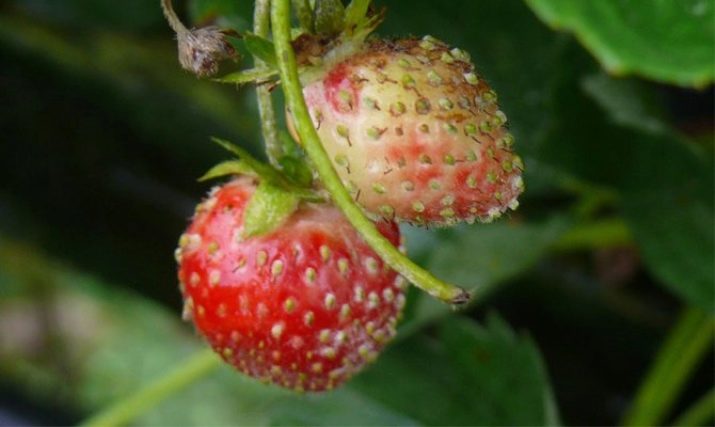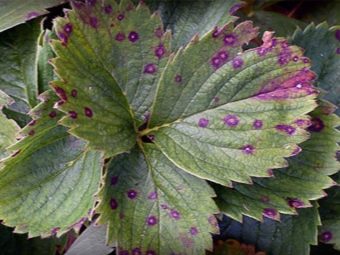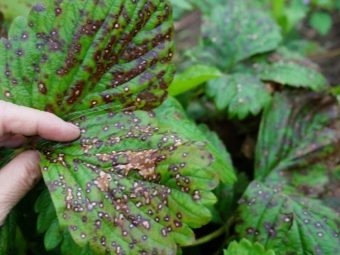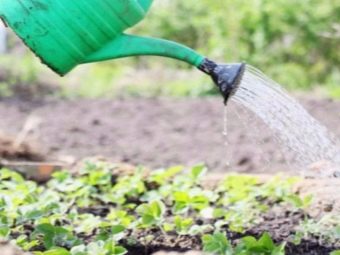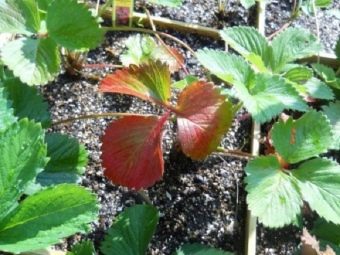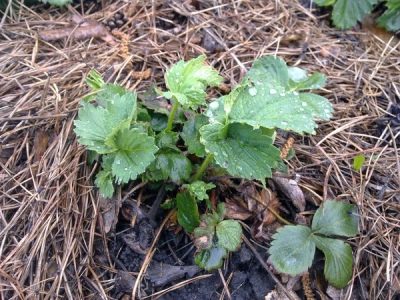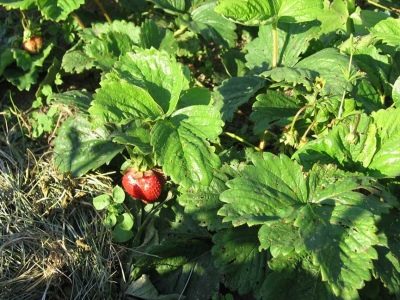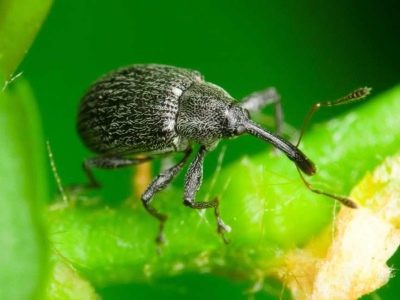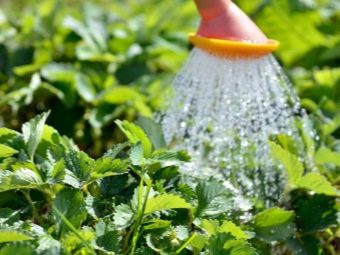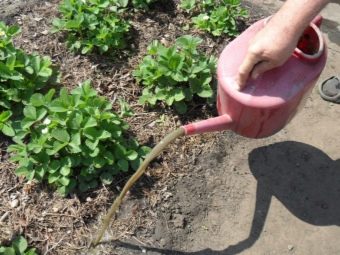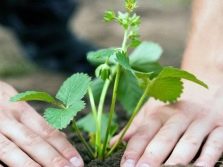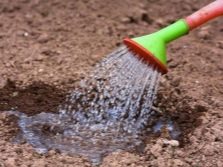Strawberries dry and brown: causes and solutions
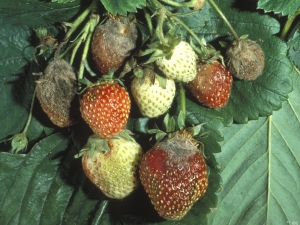
Strawberries are referred to as heat-loving plants; they usually ripen by the end of May - the beginning of June. This berry is not fastidious, but, like any other culture, needs to be cared for. Every person who decides to grow this berry can face a problem when strawberries dry and brown. The reason is to find as quickly as possible, and eliminate it in the most effective way.
The reasons
What to do when, in anticipation of a good and tasty harvest, strawberries are produced, which, before they ripen, dried up? What could have caused the situation when the berries turned brown, acquired a brown-yellow color, became leathery, mummified and bitter in taste? Most often, the fruits are hard and harden when the plant is weakened and influenced by environmental factors. Consider the most common causes of drying.
Fungal diseases of strawberries
Often the plant is attacked by spotting, gray rot, powdery mildew, black rot of fruits, late blight. The appearance of strawberry rot is the result of an insufficient amount of light and heat, poor care, the spread of fungus from an infected bush to a healthy one. These diseases are extremely dangerous, as they quickly spread not only to the berries, causing them to become unusable, but also to the plant as a whole.
Ignoring the treatment of infection is the reason why many gardeners lose their harvests.
Improper watering and lack of normal ventilation
First of all, after the discovery of the situation that the fruit on the strawberry ripens and immediately dries out, you need to check whether the plant receives enough moisture. A large amount of liquid culture requires not only at the time when its fruits are poured, but also throughout the entire period of fruiting. The lack of moisture can be seen by assessing the appearance of the plant. In such a strawberry will be dry and small fruits, as well as foliage. The need for watering is indicated by cracks in the soil and its dryness.
Presence of pests
The reason why the strawberry is brown and does not blush can be hidden in the attack of the parasite. The most common pests include the following insects.
- Stem nematode. During the attack of the pest there is a lag in growth, thickening of the foliage, its wilting and twisting, death of flowers and deformation of the ovaries. Those berries that have been formed stop growing and dry out.
- Earthen mite This pest begins to activate in early spring, when the plant is still weak. As a result, the culture becomes ill, and the fruits are small and dry.
- Raspberry-strawberry weevil.
Lack of trace elements and minerals
You can determine this cause by yellowed and dried berries.
How to fix the problem?
If a fungal infection is found on a strawberry bush, it should be immediately destroyed. using effective drugs and methods:
- gray rot - “Switch” or “Horus”;
- black root rot - digging out a plant with a root system and treating the soil with a disinfectant;
- black rot it is impossible to cure the fruits with preparations; for its liquidation, the diseased berries are broken and burned;
- late blight - proper preventive measures;
- powdery mildew - spraying the foliage with mineral fertilizers, as well as treatment with "Topaz" during flowering.
Pests that destroy the plant, sucking all the juice out of it - this is the reason that should be quickly eliminated, so that the berries do not dry and do not darken. If the parasite was found in the springtime, then it is necessary to spray the plant with Malophos and colloidal sulfur. Insecticides, in particular “Inta-vir”, help from weevils. A one-time chemical treatment may not destroy all insect pests, so re-spraying is advisable.
Do not forget about watering strawberries in hot and dry summers. The important point is that excessive moisture should not be tolerated either, since excessive moisture contributes to the activation of various bacteria. Many of these microorganisms provoke the development of diseases, during which the berries become hard and unsuitable for consumption.
Emergency top dressing of strawberries is what needs to be done if the soil is poor and has not been fertilized for a long time, and the crop does not bring the desired result. Nitrogen and magnesium fertilizers will help to save the situation, magnesium sulphide gives a good result.
To feed the soil you need to start only when you know for sure that the plantation is not infected with a fungal infection. If the plants are diseased, then fertilizer can aggravate their situation.
Preventive actions
Kik is well aware that it is much easier to prevent a situation than to correct it. That is why it is better to deal with diseases and pests that cause hardening and dark strawberry fruit with proper preventive measures:
- for planting it is worth using only a strong, healthy seedling;
- planting should be carried out at the correct distance to avoid pollination and weaving of whiskers;
- old plants are most often infected with diseases and parasites, therefore, it is necessary to replant the plant every three years;
- Strawberries should not be planted on the territory where tomatoes, peppers, eggplants and potatoes used to grow, as their parasites and fungal spores can get on strawberries;
- it is necessary to treat the soil with boiling water, it is able to destroy all the larvae of the pest;
- Planting mustard, garlic or onion is an excellent preventative measure that will help save the fruit;
- weeds must be constantly destroyed, as they are a favorable environment for the development of infections;
- constantly monitor the soil moisture.
Do not forget that insufficiently fed soil - the cause of the development of a weak plant. That is why fertilizing is necessary for preventive purposes. After harvesting, be sure to fertilize the soil, since all the nutrients it contains have gone to ripen the berries. Ammonium fertilizer is suitable in this situation as well as possible. It is worth carrying out the procedure in August, and if there were no fruits on the strawberries, then in spring time.
Tips and tricks
In order to get a good, healthy and tasty strawberry harvest, it will take a lot of effort. Experienced gardeners and people who have been engaged in the cultivation of strawberries for many years, give these tips:
- before planting a young sapling dip in hot water for fifteen minutes, and then in cold water;
- immediately before planting, treat the plant with insecticides that will destroy not only the fungal infection in the soil, but also the larvae of the pest;
- watering strawberries should be done regularly, but in order not to re-moisten the soil, the land should dry by a few centimeters before the next irrigation;
- you should not plant strawberries on a dense soil mixture;
- Do not be lazy with preventive treatment Bordeaux liquid and implement it regularly.
Judging by the opinions of those who like to grow strawberries, a biological effect, which is based on the fungus Trichoderma, gives a good effect of healing the soil. It is able to suppress many types of pathogens of dangerous diseases.
Also, summer residents recommend the use of green manure from the cabbage family. If a problem arises, when the strawberry does not blush and, failing to ripen, spoils, it is necessary to find the true cause that caused this situation, and only then begin to fight it. Do not overlook the proper care of your favorite plants.
For information on what causes and solutions to the problem when strawberries dry and brown, see the next video.

